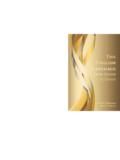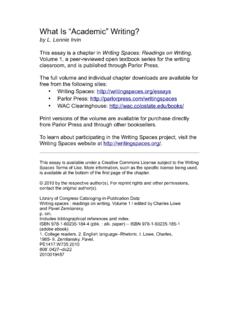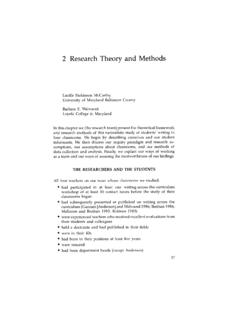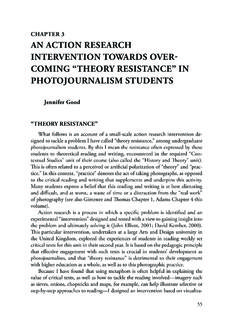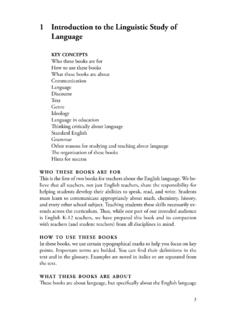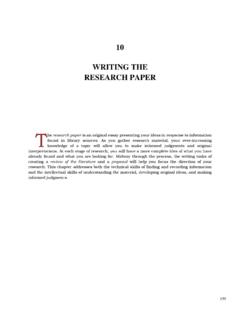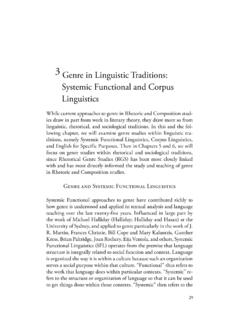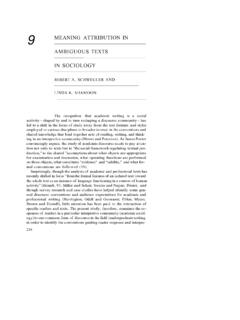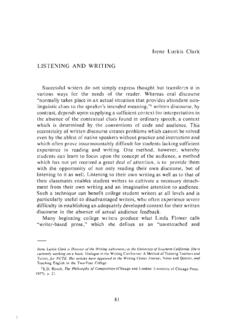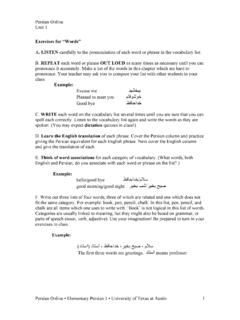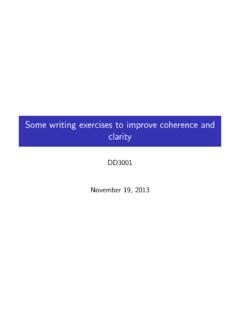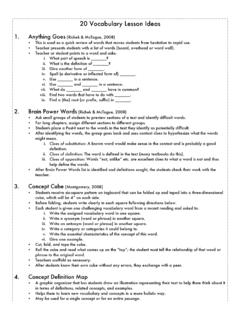Transcription of 3 A Skeletal Introduction to English Grammar
1 573 A Skeletal Introduction to English Grammarkey conceptsClausesSentencesPhrasesComplemen tation and modificationWordsMorphemesParts of speechRegular and irregular formsGrammatical categoriesSounds and spellingForm, function, meaningintroductionThis chapter has a number of purposes. First, it aims to place the study of Grammar within the larger study of discourse and text. Second, it aims to provide a review of traditional grammatical concepts and terminol-ogy for those who have studied Grammar before. If you have not studied Grammar before, it will give a very simple Introduction to grammatical ideas and plenty of practice in using those ideas in straightforward exer-cises.
2 Third, it provides a basis for the deeper and more critical study of language that we present in the remainder of this book and in Book II. In this chapter we only provide examples of concepts; we do not justify those concepts or their application (though we will sketch how to justify analyses in our section on Form, Function, and Meaning). Our goal is to help you get up to speed in recognizing basic grammatical elements. Because the presentation in the following chapters progresses from the smallest units (sounds), and works upward to the largest (sentences), we begin this chapter with the largest units, clauses and sentences, and work downward to the smallest.
3 We use language to communicate with each other. This communica-tion may occur in conversation, which can be either directly face-to-face or mediated by some technology such as the telephone. We may also com-municate by writing to each other. Communication in which language is used is called discourse and the products of discourse are called texts, which can be recordings of spoken communication or the writings that constitute a written discourse. Discourse is coherent, cohesive, contex-tualized, and purposeful communicative activity. We will have more to Delahunty and Garvey 58say about discourse and texts in our chapter on Discourse.
4 The texts that realize a discourse are composed of various kinds of linguistic units, the most important of which is the sentence. The sentence is the largest unit to which the grammatical rules of a language apply. Sentences are com-posed of one or more clauses; a clause is composed of at least two phrases, one of which plays the role of subject, the other, of predicate; phrases are composed of one or more words functioning as a single grammatical unit; words are composed of morphemes; morphemes are meaningful sequences of phonemes (units of sound); phonemes are the units of sound that distinguish words or morphemes from each other.
5 They are repre-sented more or less adequately by letters of the sentences are composed of one or more clauses, we begin with a discussion of the latter. Clauses represent simple states of affairs. These may be states or events. States are unchanging situations; events are situations in which something changes. The simplest type of complete clause must have two phrases, one func-tioning as the subject and the other as the predicate. In the following ex-amples the subject is italicized and the predicate is bolded. Note that both subject and predicate can consist of one or more words: Squirrels jump.
6 Dogs chase cats. Jack and Jill ran up the hill. A clause is composed of a subject and a predicate. You should have been there. The students left the room quietly. the little lame baloonman whistled far and wee ( cummings) Reality TV is a crashing bore. He tried to avoid the freighter. The author was born in 1943. FDR was a great leader. Their voices make up the story. Husbands give wives flowers. Linguistics will expand knowledge of language. The book deals with contemporary issues in political ethics. Four people were killed today in a small plane crash in San Diego. It is raining. You know the answers to most of these Skeletal Introduction to English GrammarExercise1.
7 Put brackets around the complete subject and complete predicate in each of the following clauses. For example, [All politicians] [give speeches]. (Subject) (Predicate) a. This section has a number of purposes. b. We provide copious exercises for you. c. Sentences stand alone. d. We begin with easy exercises. e. Beginning writers leave out parts of sentences. f. I need a cup of tea. g. You should try yoga for your nerves. h. Karate is excellent exercise . i. The queen may move any distance in any direction. j. Alice and the March Hare went to the Mad Hatter s tea party.
8 K. Politicians lie. l. Politicians tell lies. m. Our library is rather small. n. Its collection consists of old books. o. It is raining heavily. p. The astronauts sent greetings to the A very simple question: What is the typical order of subject and predicate in English clauses? Besides occurring before the predicate, subjects are often defined as the phrase that represents something about which something is said by the predicate, or about which the predicate answers a question. For instance, we can view the subjects (italicized) in the following clauses as representing something about which the predicates (bolded) say something or answer a question about the subject.
9 For instance, What can we say about dogs? They bark: Dogs bark. Flannery O Connor wrote several books. His mother sent him a care package. He paid an unscrupulous dealer $400,000 for a vintage DB 6. Subjects are traditionally viewed as expressions that represent the doer Delahunty and Garvey 60of the action represented by the verb of the clause. They can often answer the question, Who did what the predicate describes? For example, Who wrote many great plays? Oscar did. This is true in the following examples: Donald ate a pizza. Dick walked the dog. Peggy went to the concert. Notice that the subject is the first word or phrase in each of the clauses above.
10 This is often the case, but not always. In the following examples, another phrase precedes the subject. Again, the subjects are italicized: In the stormy seas, Jim O Neill is doing his best to win a yacht race. Manipulated by MI6, O Neill is dragged into a bloody the subject and predicate in the following clauses. a. Fortunately, I still have time to prepare for the semester s class-es. b. According to the great majority of atmospheric scientists, the earth is warming alarmingly. c. Evidently, the globe is in for increasingly extreme weather. d. Surprisingly, people are not doing very much about this.
